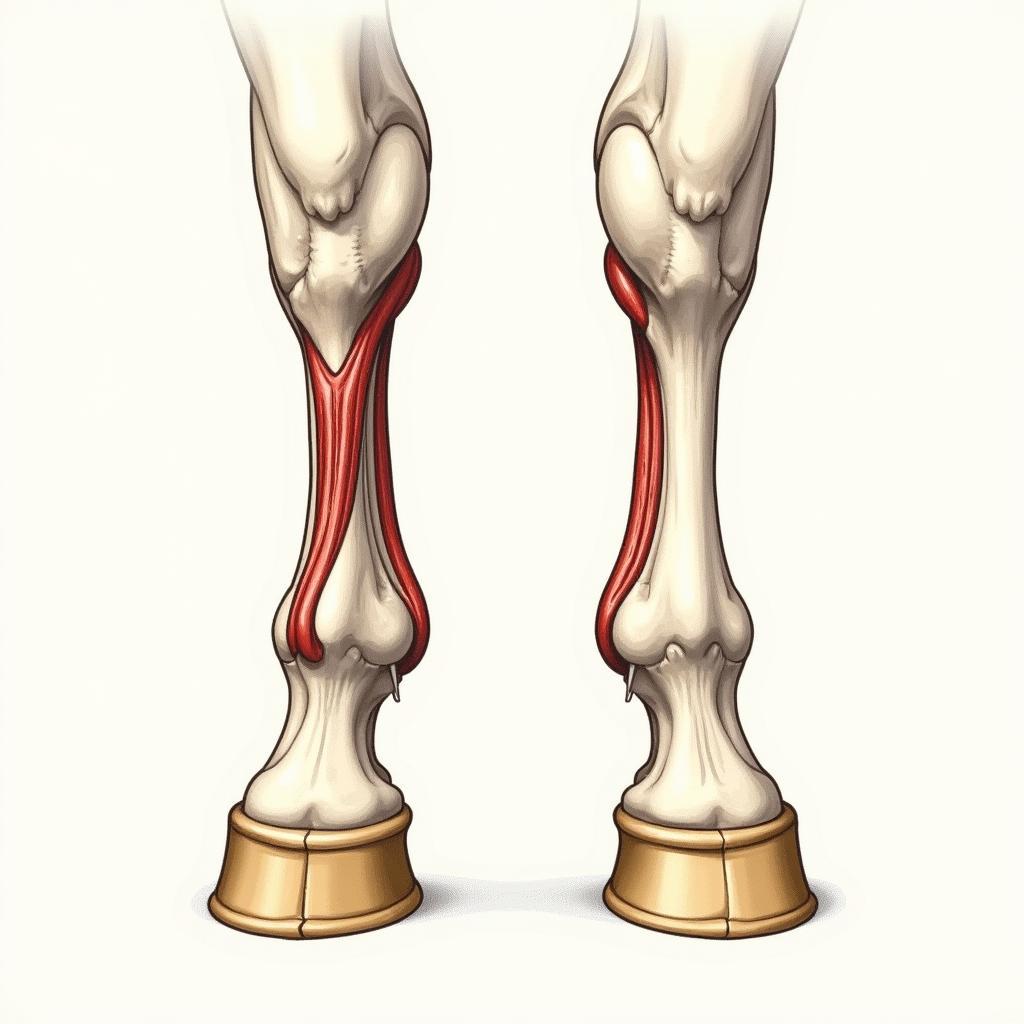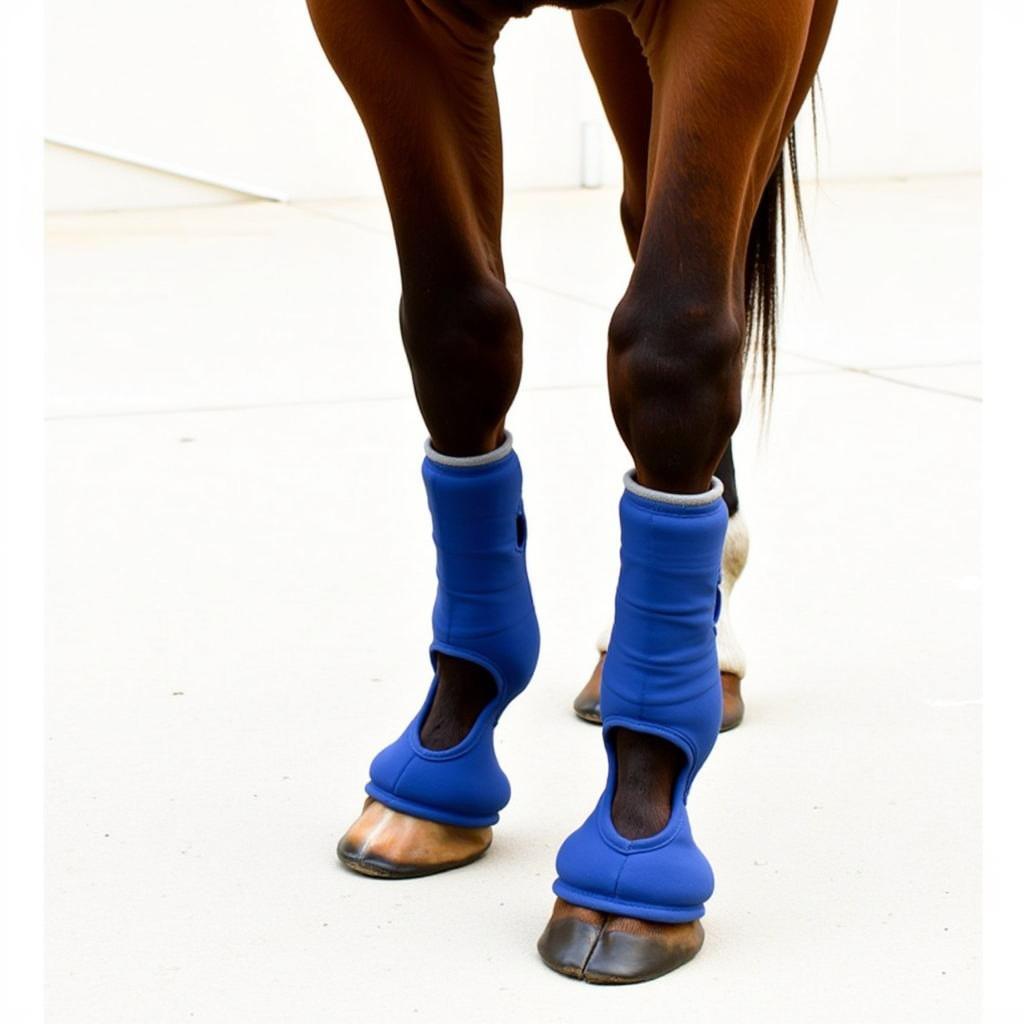Horse Hock Ice Boots are becoming increasingly popular among horse owners and for good reason. They provide a range of therapeutic benefits for horses of all disciplines, helping to soothe inflammation, reduce swelling, and promote healing in the hock joint. Whether your equine partner is a seasoned athlete or a leisurely trail horse, understanding the benefits and proper use of horse hock ice boots can contribute to their overall well-being and performance.
 Horse Hock Anatomy
Horse Hock Anatomy
What are Horse Hock Ice Boots?
Horse hock ice boots are specifically designed wraps that provide targeted cold therapy to the horse’s hock joint. They typically consist of a durable outer layer, often made of neoprene or nylon, and an inner compartment filled with ice packs or gel inserts. The contoured shape of these boots ensures a snug fit around the hock, allowing for maximum cold penetration to the underlying tissues.
The Benefits of Using Horse Hock Ice Boots
The use of horse hock ice boots offers a multitude of benefits, particularly for horses recovering from strenuous activity or those managing chronic conditions. Let’s delve into some of their key advantages:
Reducing Inflammation and Swelling
Cold therapy effectively constricts blood vessels, minimizing blood flow to the affected area. This vasoconstriction helps to reduce inflammation and swelling, providing relief from pain and discomfort.
Pain Management
By reducing inflammation and swelling, horse hock ice boots play a crucial role in alleviating pain. Cold therapy numbs the area, effectively disrupting the transmission of pain signals to the brain.
 Horse Wearing Hock Ice Boots
Horse Wearing Hock Ice Boots
Promoting Healing
Cold therapy can aid in the healing process by reducing cellular metabolism and oxygen demand in the injured tissues. This process helps to minimize further tissue damage and creates an optimal environment for healing to occur.
Preventing Further Injury
By reducing inflammation and pain, horse hock ice boots can help prevent your horse from favoring the affected leg. This is crucial in preventing compensatory injuries that may arise from altered gait and weight distribution.
When to Use Horse Hock Ice Boots
Horse hock ice boots can be beneficial in various situations, including:
- After strenuous exercise or competition: Applying ice boots after intense workouts helps to reduce inflammation and prevent swelling, supporting quicker recovery.
- Managing chronic conditions: For horses with arthritis or other degenerative joint diseases, regular use of ice boots can manage pain and inflammation, improving their quality of life.
- Following an injury: In cases of sprains, strains, or other hock injuries, ice boots can help minimize swelling and promote healing.
 Veterinarian Examining Horse Hock
Veterinarian Examining Horse Hock
“Regular use of hock ice boots, especially after intense training, can significantly contribute to a horse’s long-term soundness,” says Dr. Emily Carter, a renowned equine veterinarian specializing in sports medicine.
Choosing the Right Horse Hock Ice Boots
Selecting the appropriate horse hock ice boots is crucial to ensure optimal comfort and effectiveness. Consider the following factors:
- Size and fit: Ensure you choose the correct size for a snug fit without being too tight.
- Type of ice pack or gel insert: Ice packs offer intense cold, while gel inserts provide a more gradual cooling effect.
- Durability and ease of use: Opt for boots made from high-quality materials and featuring user-friendly closures.
Horse Hock Ice Boots: A Valuable Tool for Equine Wellness
Horse hock ice boots are a valuable addition to any horse owner’s toolkit. By understanding their benefits and proper usage, you can contribute to your equine companion’s overall comfort, performance, and longevity.
For more information on caring for your horse’s legs and joints, you can explore our articles on horse arthritis supplements, pinch boots horses, and cloud horse boots. Additionally, understanding common conditions like horse tendonitis and the anatomy of the hock on a horse can provide valuable insights into their care. Remember to consult with your veterinarian for personalized advice and treatment plans.
FAQ
Q: How long should I leave horse hock ice boots on?
A: It’s generally recommended to ice your horse’s hocks for 20-30 minutes at a time, several times a day.
Q: Can I use horse hock ice boots on other parts of the leg?
A: While some boots may be versatile, it’s best to use boots specifically designed for the hock joint for optimal fit and effectiveness.
Q: Are there any risks associated with using horse hock ice boots?
A: While generally safe, it’s essential to follow instructions carefully. Prolonged exposure to extreme cold can potentially damage skin tissues.
Q: Can I use horse hock ice boots on a pregnant mare?
A: It’s always best to consult your veterinarian before using any new treatments on a pregnant mare.
Q: What are some signs that my horse may be experiencing hock pain?
A: Signs of hock pain can include lameness, swelling, heat in the joint, reluctance to move, and difficulty backing up or picking up the hind legs.
Need help choosing the right horse hock ice boots for your equine partner? Contact us at Phone Number: 0772127271, Email: [email protected], or visit us at QGM2+WX2, Vị Trung, Vị Thuỷ, Hậu Giang, Việt Nam. Our dedicated team is available 24/7 to assist you.